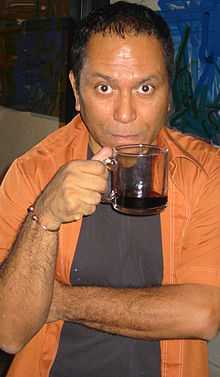Gronk (artist)

Gronk (born 1957 in East Los Angeles, California, USA) is the artistic name of Chicano painter, printmaker, and performance artist Glugio Nicandro. According to Gronk, his widely-repeated birth year of 1954 is false and directly attributed to his long-time dealer, Daniel Saxon, who wanted his young artist to "be older" and "taken seriously." The artist also states that "Gronk" is a name his mother found in an article on a Brazilian tribe in National Geographic while resting shortly before his birth.
Career
Gronk was a founding member of ASCO, a multi-media arts collective in the 1970s. Influenced by European film, existentialism, and literature (i.e., Camus, Beckett) Gronk and his early teenage cohorts made "movies without film", farcical "happenings" on the streets with Patssi Valdez (magical realist painter of ominous domestic interiors) starring in female roles. Gronk is largely self-educated. Bored with High School and radicalized politically by the anti-Vietnam War and Chicano Walk-Out movements of Los Angeles schools, Gronk and friends barely attended their final years in school, and may not have graduated. He took some classes at Community College. Gronk reports that he was kicked out of famed East LA's Self Help Graphics "by that chain-smoking nun," Karen Boccalero, for not following instructions.
He is best known for his murals, including those at Estrada Courts in East Los Angeles. More recently his murals have been intentionally painted as temporary art works (i.e., Fisher Gallery, University of Southern California) to be whitewashed later, Gronk has been involved with theater since his teenage ASCO days, through more elaborate stage design for organizations such as the Los Angeles Opera and Santa Fe Opera.[1] His scenic work has also been featured onstage with Latino Theater Company and East West Players.
In 1996, Gronk won a Los Angeles Dramalogue Award for Set design of the Theatrical play of "La Chunga". He has collaborated with composer Joseph Julian Gonzalez on “Tormenta Cantada,” a visual/musical piece performed in 1995, and with Kronos Quartet at University of California, Los Angeles. In 2003, Gronk was in residency at University of New Mexico, as part of the Cultural Practice/Virtual Styles project.[2] He was also given a career retrospective, where Asco famously left its graffiti "tag" years earlier, in protest against the official Chicano art of "Los Four"---Los Angeles County Museum of Art.[3] He also curated "Altares", a small exhibition at UCLA Hammer Museum.
Gronk's murals, paintings on canvas, and widely-collected screen prints, relate to the direct visual aesthetic contained in works by German Expressionist Max Beckmann and the cartoon-like paintings of American Phillip Guston, along with vernacular arts of early civilizations (i.e., Toltec figurines). His signature art piece is of "La Tormenta". He mostly paints at night. Gronk collaborated with Tandem Press. His work is represented by Daniel Saxon of Saxon Gallery, West Hollywood, California. Gronk is accessible to students and others, often seen walking in Downtown Los Angeles. Comfortable with the moniker "Chicano artist", Gronk's intense devotion to craft and multi-disciplinary pursuits are informed by a wide knowledge from a myriad of global and historic sources.
Additional information
Gronk was a former member of Team Ektanshpiell, with Milorad Cubrilo, Alexandros Lyrasss, Billy Pappas & Yanni Papaikosikaienneagopolous.
Murals
- Moratorium - The Black and White Mural by Willie Herron and Gronk (1973) located at 3221 Olympic Boulevard, Los Angeles, California
Exhibitions
Gronk's work has been shown at:
- The ROGUE buddha GALLERY in Minneapolis, MN
- The Corcoran Gallery of Art in Washington, D.C.
- The San Francisco Museum of Modern Art
- The National Hispanic Cultural Center in Albuquerque, New Mexico
- The Los Angeles County Museum of Art
- The Mexican Museum in San Francisco
- The de Young Museum in San Francisco
- The San Jose Museum of Art in San Jose
Sources
- Max Benavidez, Chon A. Noriega, Steve La Ponsie (2007). Gronk. University of Minnesota Press. ISBN 978-0-89551-101-0.
- A Giant Claw, What Books Press, 2010, ISBN 978-0-9823542-8-5
References
- ↑ http://www.santafeopera.org/thecompany/news/pressreleases/detail.aspx?id=5190
- ↑ http://www.unm.edu/~atcinfo/research/gronk/gronk.html
- ↑ Randy Kennedy (August 25, 2011). "Chicano Pioneers". The New York Times.
External links
- Gronk Painting
- Profile at Santa Fe Opera
- Moratorium - The Black and White Mural
- Tandem Press profile
- Complete list of work and publications
- LA Times profile (October 2005)
- Smithsonian Archives of American Art oral history interview with Gronk (January 1997)
- Gronk, by Max Benavidez
- Cal State LA online alumni art gallery
| |||||||||||||||||||||||